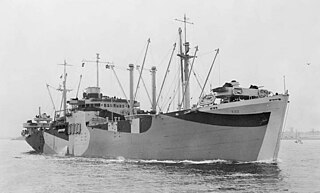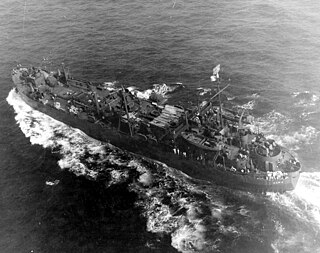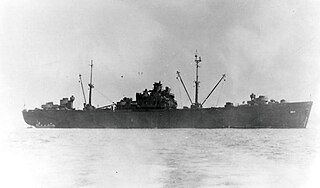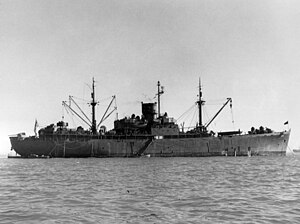
The Balao class was a design of United States Navy submarine used during World War II, and with 120 boats completed, the largest class of submarines in the United States Navy. An improvement on the earlier Gato class, the boats had slight internal differences. The most significant improvement was the use of thicker, higher yield strength steel in the pressure hull skins and frames, which increased their test depth to 400 feet (120 m). Tang actually achieved a depth of 612 ft (187 m) during a test dive, and exceeded that test depth when taking on water in the forward torpedo room while evading a destroyer.

Type C1 was a designation for cargo ships built for the United States Maritime Commission before and during World War II. Total production was 493 ships built from 1940 to 1945. The first C1 types were the smallest of the three original Maritime Commission designs, meant for shorter routes where high speed and capacity were less important. Only a handful were delivered prior to Pearl Harbor. But many C1-A and C1-B ships were already in the works and were delivered during 1942. Many were converted to military purposes including troop transports during the war.
USS Triana (IX-223), an unclassified miscellaneous vessel, was the second ship of the United States Navy to be named for Rodrigo de Triana, the discoverer of the Americas.

USS Monadnock (ACM-10) was a coastal minelayer in the U.S. Navy, the third vessel named after Mount Monadnock, a solitary mountain (monadnock) of more than 3,100 feet in southern New Hampshire close to the border of Massachusetts. The ship was built as the cargo vessel Cavalier for the Philadelphia and Norfolk Steamship Company by Pusey and Jones Corporation, Wilmington, Delaware in 1938. The Navy purchased the ship 9 June 1941 for wartime use. After decommissioning the ship was sold in June 1947 for commercial use then sold to a Panamanian company in 1949 to be renamed Karukara. In 1952 the ship became Monte de la Esperanza for a company in Bilbao, Spain transporting bananas to the United Kingdom from the Canary Islands for more than 20 years. She was later sold to the Marine Institute of Spain for operation as a hospital ship for more than 10 years serving the fishing fleet of the Canary Islands as Esperanza del Mar until becoming an artificial reef off Spain in 2000.

USS Hilo (AGP-2) was a converted yacht that saw service as a motor torpedo boat tender in the United States Navy during World War II. It was originally the yacht Caroline built for Eldridge R. Johnson and launched 18 July 1931. Caroline was at the time the second largest yacht and largest American built Diesel yacht. It was built with a laboratory as well as palatial quarters and was loaned and equipped by Johnson for the Johnson-Smithsonian Deep-Sea Expedition of 1933 that explored the Puerto Rico Trench. The yacht was sold in 1938 to William B. Leeds and renamed Moana replacing an earlier Leeds yacht of the same name.

Motor torpedo boat tender is a type of ship used by the U.S. Navy during World War II and Vietnam War. The motor torpedo boat tender's task was to act as a tender in remote areas for patrol boats (PT-boats) and to provide the necessary fuel and provisions for the torpedo boats she was responsible for. The type finds its root in the torpedo boat tender, developed in the 19th century.

USS Jamestown (PG-55) was a patrol gunboat and after 13 January 1943 a Jamestown-class motor torpedo boat tender acquired by the U.S. Navy during World War II. Her task in her final classification was to provide a "home base" for torpedo boats in remote parts of the ocean during the war, and to provide them with necessary services, such as fuel, food, and repairs.

USS Portunus (AGP-4) was an LST-1-class tank landing ship acquired by the U.S. Navy for use during World War II as a motor torpedo boat (MTB) tender. She was named after a Roman god of the sea, who had jurisdiction over ports and the shores.

USS Oyster Bay (AGP-6), originally and later AVP-28, was a United States Navy motor torpedo boat tender in commission from 1943 to 1946. She saw service in World War II.

USS Crystal (PY-25), built in 1929 as the yacht Cambriona for Walter O. Briggs of Detroit, Michigan, was a patrol yacht in the United States Navy. The Navy acquired the yacht in January 1942 as Vida commissioning the vessel as Crystal in February. Naval service was in Hawaii until November 1945. After sale in November 1947 the vessel operated commercially in Central and South America.
USS Tipton (AK-215) was an Alamosa-class cargo ship that was constructed for the US Navy during the closing period of World War II. She was commissioned; however, the war ended and she was declared "excess to needs." She was then transferred to the US Coast Guard in 1946.

USS Zircon (PY-16) was the private yacht Nakhoda acquired by the United States Navy in 1940 serving as an armed yacht from 1941 to 1946. The yacht Nakhoda was built for automobile executive Frederick J. Fisher by Pusey and Jones Corporation, Wilmington, Delaware delivered in 1930. After the war the yacht was sold and reverted to the original name until sold in 1951 to the United New York Sandy Hook Pilots Association and renamed New York.

USS Wachapreague (AGP-8) was a motor torpedo boat tender in commission in the United States Navy from 1944 to 1946, seeing service in the latter part of World War II. After her Navy decommissioning, she was in commission in the United States Coast Guard from 1946 to 1972 as the cutter USCGC McCulloch (WAVP-386), later WHEC-386, the fourth ship of the U.S. Coast Guard or its predecessor, the United States Revenue Cutter Service, to bear the name. In 1972 she was transferred to South Vietnam and served in the Republic of Vietnam Navy as the frigate RVNS Ngô Quyền (HQ-17). Upon the collapse of South Vietnam at the end of the Vietnam War in 1975, she fled to the Philippines, and she served in the Philippine Navy from 1977 to 1985 as the frigate RPSGregorio del Pilar (PF-8) and from 1987 to 1990 as BRP Gregorio del Pilar (PF-12).

USS Orestes (AGP-10) was a motor torpedo boat tender that served in the United States Navy from 1944 to 1946.

USS Callisto (AGP-15) was a Portunus-class motor torpedo boat tender built for the United States Navy during World War II. It was originally ordered as USS LST-966 an LST-542-class tank landing ship, but renamed and re-designated in August 1944.

USS Acontius (AGP-12) was a motor torpedo boat tender in service with the United States Navy from 1944 to 1946. She was scrapped in 1965.

USS Alecto (AGP-14) was a Portunus-class motor torpedo boat tender built for the United States Navy during World War II. She was originally ordered as USS LST-977 an LST-542-class tank landing ship, but renamed and re-designated on 12 June 1944.

USS Samar (ARG-11) was a Luzon class internal combustion engine repair ship that saw service in the United States Navy during the final days of World War II, and in the post-war period. Named for the Samar Island in the Philippines, it was the second U.S. Naval vessel to bear the name.

USS Antigone was a Portunus-class Motor Torpedo Boat Tender in service with the United States Navy during World War II. Authorized originally as LST-773, She was reclassified Motor Torpedo Boat Tender, and laid down the next day at Chicago Bridge & Iron Co., Seneca, IL. On 27 October 1944, she was launched, and put into reduced commission for conversion to a Motor Torpedo Boat Tender. On 5 December 1944, she was decommissioned for the conversion at Maryland Drydock Co., Baltimore, MD. 160 days later, on 14 May 1945, Antigone was put into full commission. After serving in the Asiatic-Pacific Theater for a year, Antigone was decommissioned on 27 May 1946, at San Francisco. On 10 June 1947, she was struck from the Naval Register, and sold to the Maritime Administration for final disposal on 6 February 1948 and simultaneously sold to Kaiser & Co., for scrapping.

USS Chiron (AGP-18) was a Portunus-class motor torpedo boat tender which saw brief service with the United States Navy during and just after World War II. She then served as the Argentinian merchant ship MV Altamar until she sank in 1960.

















